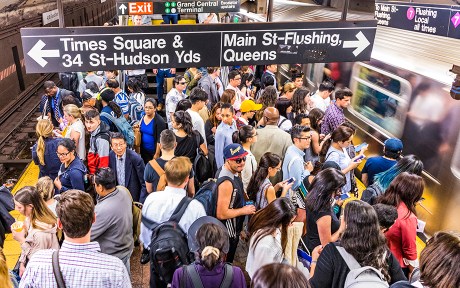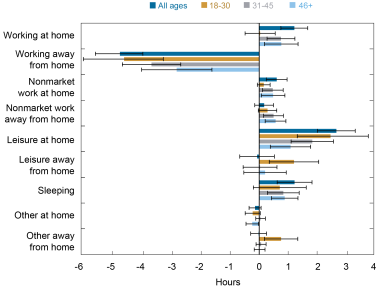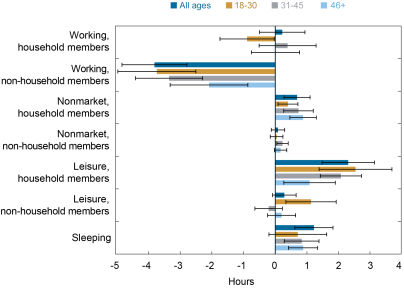
The COVID-19 pandemic has dramatically changed the way Americans spend their time. One of the most enduring shifts has occurred in the workplace, with millions of employees making the switch to work from home. Even as the pandemic has waned, more than 15 percent of full-time employees remain fully remote and an additional 30 percent work in hybrid arrangements (Barrero, Bloom, and Davis). These changes have substantially reduced time spent commuting to work; in the aggregate, Americans now spend 60 million fewer hours traveling to work each day. In this post, we investigate how people spend this saved time on other activities. Using detailed data from the American Time Use Survey (ATUS), we find that employed individuals allocate their saved commute time toward leisure activities and sleeping, while reducing overall work hours.
Measuring Time Spent
The ATUS is a nationally representative survey that measures both the amount of time people spend on various activities and where these activities take place. ATUS respondents are randomly selected from a subset of households in the Current Population Survey, allowing us to link demographic and employment information to respondents’ time use information. Because COVID-19 disrupted the survey’s data collection between March 18 and May 9 of 2020, the survey results for 2020 reflect data only from May 10 to December 31. To make comparisons with prior years, we restrict the data to this period in the other years as well.
To examine how workers allocate their saved commute time, we apply the methodology of Aguiar, Hurst, and Karabarbounis to the COVID-19 period. For those interested in the details, we aggregate individual ATUS responses to the state-level and exploit variation across states in the extent of commute time reduction. After categorizing more than 400 time use activities into nine major categories, we regress yearly changes in time use for each category on changes in commute time. Our first-differences approach enables us to account for time-invariant state characteristics, and we also include a variety of state-level control variables to account for worker composition. Across specifications, we restrict our analysis to employed individuals in order to exclude reductions in commute times due to job loss. Additionally, to account for the possibility that COVID-19 induced firms to cut hours just as employees were shifting to remote work, we also consider a sample of only full-time employees and find similar results.
Changes in Time Use
The main results are presented in the chart below in which we show how one hour of foregone commute time is allocated toward other activities. First, we find a substantial fall in time spent working; the decrease in hours worked away from home is only partially offset by an increase in working at home. This is in line with results from Bloom, Han, and Liang, who find that remote work led to a decrease in overall hours worked. Moreover, our findings help reconcile earlier work on commute times, which found that even though employees reported allocating 35 percent of their saved commute time to work, they spent fewer total hours in paid employment (Barrero, Bloom, and Davis). Our results from the ATUS suggest that although individuals may have increased time working in the precise time-slot they used to commute, overall paid-work hours fell because of substitution toward other activities throughout the day.
Second, we see notable increases in leisure time and sleeping. The rise in leisure was particularly pronounced among younger Americans, who reported spending more time at social events, eating at restaurants or bars, and exercising. Older age groups, on the other hand, tended to allocate more time to nonmarket work, such as activities related to childcare, the maintenance of the household, repairs, and meal preparation.
Employees Decreased Time Spent Working and Increased Their Leisure and Sleeping

Note: Error bars represent 90% confidence intervals.
Who Are the Activities Conducted With?
The ATUS also includes information on who physically accompanied the respondent during each activity. We use this variable to classify which activities were done with people outside of the immediate household. We categorize solitary activities and those with household members into one category, and activities with friends, co-workers, clients, and non-household family members into the other. As we would expect, the next chart shows that time spent on activities done alone or with household members increased, such as leisure (+2.30 hours) and nonmarket activities (+0.69). Differentiating by age, we see that younger people were the only group to significantly increase their leisure time with non-household members (+1.13), likely reflecting the differential risks of COVID-19.
Decreases in Commuting Times Correlate with Increases in Activities Conducted Alone or with Household Members

Notes: Error bars represent 90% confidence intervals. We categorize solitary activities and those with household members into one category.
Our results show important relationships in the substitutability of time use. The findings lend credence to the various reports on employees’ preferences for flexible work arrangements, given that cutting the commute enables people to spend their time on other activities, such as childcare or leisure. This added benefit of working from home—for those who want it—will be an important consideration for the future of flexible work arrangements.

David Dam is a former research analyst in the Federal Reserve Bank of New York’s Research and Statistics Group.

Davide Melcangi is a research economist in Labor and Product Market Studies in the Federal Reserve Bank of New York’s Research and Statistics Group.

Laura Pilossoph is an assistant professor of economics at Duke University.

Aidan Toner-Rodgers is a research analyst in the Federal Reserve Bank of New York’s Research and Statistics Group.
How to cite this post:
David Dam, Davide Melcangi, Laura Pilossoph, and Aidan Toner-Rodgers, “What Have Workers Done with the Time Freed up by Commuting Less?,” Federal Reserve Bank of New York Liberty Street Economics, October 18, 2022, https://libertystreeteconomics.newyorkfed.org/2022/10/what-have-workers-done-with-the-time-freed-up-by-commuting-less/.
Disclaimer
The views expressed in this post are those of the author(s) and do not necessarily reflect the position of the Federal Reserve Bank of New York or the Federal Reserve System. Any errors or omissions are the responsibility of the author(s).














 RSS Feed
RSS Feed Follow Liberty Street Economics
Follow Liberty Street Economics
It would also be interesting (if possible) to track productivity during working hours as well as the actual time worked. Our experience – as a fully remote company since 2008 – is that people are at their most productive when project progress and results are tracked, rather than the hours they ‘clocked in’.
No doubt, some people experiencing remote work for the first time during the pandemic will have discovered that they don’t have the temperament or training for it. Equally, many managers onto whom remote work was imposed, will be more comfortable with (outdated) ‘bums on seats’ metrics of productivity.
Having operated a remote-first business for almost 15 years, we definitely value face-to-face time, but never as a proxy for staff management. We deliberately schedule it for what works better in person – building and creating relationships.